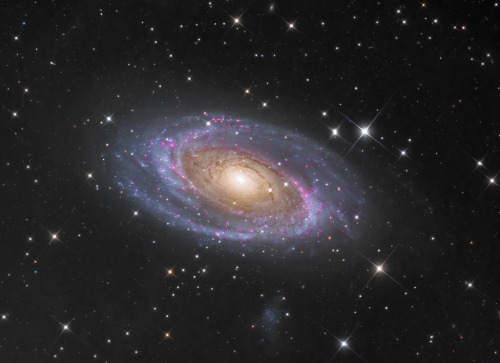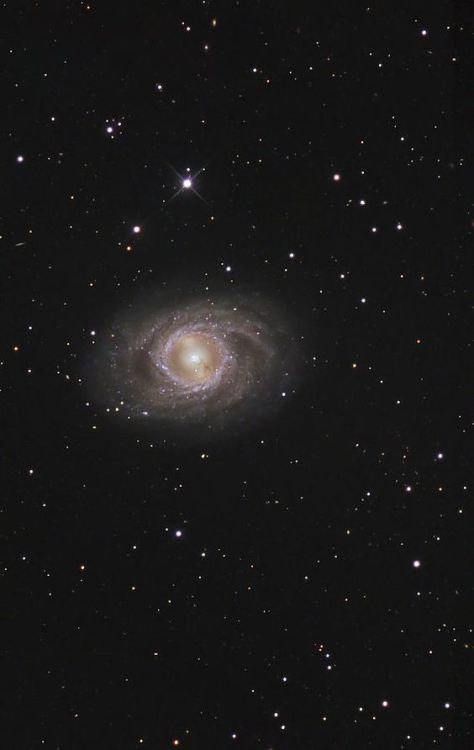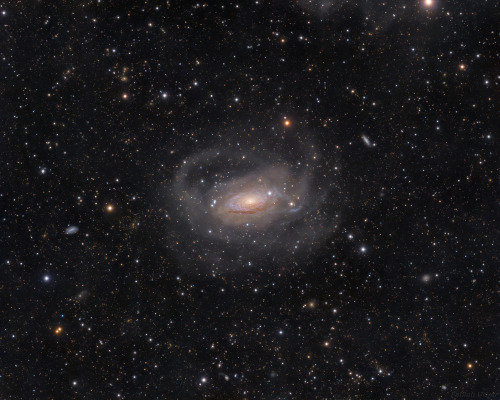#spiral galaxy
Curly Spiral Galaxy M63
Image Credit & Copyright: Fabian Neyer, Rainer Spani
Collaboration Credit: I.D. Karachentsev, F. Neyer, R. Spani, T. Zilch
Post link
This is Centaurus A!
The center of Centaurus A has a supermassive black hole with a mass of 55 million solar masses! The sudden surge of star formation in this galaxy is likely due to it being created from a spiral galaxy and elliptical galaxy colliding together.
Taken by me (Michelle Park) using the Slooh Chile One telescope on March 29th, 2022 at 7:08 UTC.
Post link
This is the Triangulum Galaxy!
Despite being a spiral galaxy, the Triangulum Galaxy has very little star formation as shown through infrared observations from the Wide-field Infrared Survey Explorer (WISE). However, a region known as NGC 604 is the largest stellar nursery between itself, the Milky Way, and the Andromeda Galaxy!
Taken by me (Michelle Park) using the Slooh Chile One telescope on March 8th, 2022 at 20:17 UTC.
Post link

This galaxy, known as NGC 5907, seems to be an elongated line of stars and dark dust. But, the galaxy is actually categorized as a spiral galaxy just like our own Milky Way. In this new image from the NASA/ESA Hubble Space Telescope, we don’t see the beautiful spiral arms because we are viewing it edge-on, like looking at the rim of a plate. It is for this reason that NGC 5907 is also known as the Knife Edge galaxy. It is about 50 million light-years from Earth and can be found in the northern constellation of Draco. Although not visible in this image, ghostly streams of stars on big arching loops extend into space, circling around the galaxy. It is believed that those are remnants of a small dwarf galaxy that was torn apart by the Knife Edge galaxy and merged with it over 4 billion years ago.
Image credit: ESA/Hubble & NASA, R. de Jong; Acknowledgment: Judy Schmidt (Geckzilla)

Magnificent spiral galaxy NGC 4565, also known as the Needle Galaxy, is viewed edge-on from Earth. This sharp, colorful image reveals the galaxy’s boxy, bulging central core, obscured by dust lanes. NGC 4565 itself lies about 40 million light-years from Earth and spans about 100,000 light-years. Easily spotted with small telescopes, sky enthusiasts consider NGC 4565 to be a prominent celestial masterpiece Messier missed.
Image Credit & Copyright: Michael Sherick

M33: The Triangulum Galaxy
The small, northern constellation Triangulum harbors this magnificent face-on spiral galaxy, M33. Its popular names include the Pinwheel Galaxy or just the Triangulum Galaxy. M33 is over 50,000 light-years in diameter, third largest in the Local Group of galaxies after the Andromeda Galaxy (M31), and our own Milky Way. About 3 million light-years from the Milky Way, M33 is itself thought to be a satellite of the Andromeda Galaxy and astronomers in these two galaxies would likely have spectacular views of each other’s grand spiral star systems. As for the view from planet Earth, this sharp image shows off M33’s blue star clusters and pinkish star forming regions along the galaxy’s loosely wound spiral arms. In fact, the cavernous NGC 604 is the brightest star forming region, seen here at about the 7 o'clock position from the galaxy center. Like M31, M33’s population of well-measured variable stars have helped make this nearby spiral a cosmic yardstick for establishing the distance scale of the Universe.
Image Credit & Copyright: Rui Liao
Hubble Space Telescope
Time And Space

Hubble’s Close-Up of Spiral’s Disk, Bulge
This image from the NASA/ESA Hubble Space Telescope shows IC 2051, a galaxy in the southern constellation of Mensa (the Table Mountain) lying about 85 million light-years away. It is a spiral galaxy, as evidenced by its characteristic whirling, pinwheeling arms, and it has a bar of stars slicing through its center.
This galaxy was observed for a Hubble study on galactic bulges, the bright round central regions of spiral galaxies. Spiral galaxies like IC 2051 are shaped a bit like flying saucers when seen from the side; they comprise a thin, flat disk, with a bulky bulge of stars in the center that extends above and below the disk. These bulges are thought to play a key role in how galaxies evolve, and to influence the growth of the supermassive black holes lurking at the centers of most spirals. While more observations are needed in this area, studies suggest that some, or even most, galactic bulges may be complex composite structures rather than simple ones, with a mix of spherical, disk-like, or boxy components, potentially leading to a wide array of bulge morphologies in the universe.
This image comprises data from Hubble’s Wide Field Camera 3 at visible and infrared wavelengths.
Text credit: ESA (European Space Agency)
Image credit: ESA/Hubble & NASA, P. Erwin et al.
Hubble Space Telescope
Time And Space

Hubble Spots Galaxy’s Dramatic Details
Some of the most dramatic events in the universe occur when certain stars die - and explode catastrophically in the process.
Such explosions, known as supernovae, mainly occur in a couple of ways. In one scenario, a massive star depletes its fuel at the end of its life, becoming dynamically unstable and unable to support its bulk, causing it to collapse inward and violently explode. In another outcome, a white dwarf (the dense remnant of a once-normal star) in an orbiting stellar couple siphons more mass off its companion than it is able to support, igniting runaway nuclear fusion in its core and beginning the supernova process. Both types result in an intensely bright object in the sky that can rival the light of a whole galaxy.
In the last 20 years the galaxy NGC 5468, visible in this image, has hosted a number of observed supernovae of both the aforementioned types: SN 1999cp, SN 2002cr, SN2002ed, SN2005P and SN2018dfg. Despite being just over 130 million light-years away, the orientation of the galaxy with respect to us makes it easier to spot these new “stars’ as they appear; we see NGC 5468 face on, meaning we can see the galaxy’s loose, open spiral pattern in beautiful detail in images such as this one from the NASA/ESA Hubble Space Telescope.
Text credit: ESA (European Space Agency)
Image credit: ESA/Hubble & NASA, W. Li et al.
Hubble Space Telescope
Time And Space

Hubble Eyes an Emitting Galaxy
For this image, the NASA/ESA Hubble Space Telescope turned its powerful eye toward an emission-line galaxy called NGC 3749.
When astronomers explore the contents and constituent parts of a galaxy somewhere in the universe, they use various techniques and tools. One of these is to spread out the incoming light from that galaxy into a spectrum and explore its properties. This is done in much the same way as a glass prism spreads white light into its constituent wavelengths to create a rainbow. By hunting for specific signs of emission from various elements within a galaxy’s spectrum of light -so-called emission lines - or, conversely, the signs of absorption from other elements - so-called absorption lines - astronomers can start to deduce what might be happening within.
If a galaxy’s spectrum shows many absorption lines and few emission lines, this suggests that its star-forming material has been depleted and that its stars are mainly old, while the opposite suggests it might be bursting with star formation and energetic stellar newborns. This technique, known as spectroscopy, can tell us about a galaxy’s type and composition, the density and temperature of any emitting gas, the star formation rate, or how massive the galaxy’s central black hole might be.
While not all galaxies display strong emission lines, NGC 3749 does. It lies over 135 million light-years away and is moderately luminous. The galaxy has been used as a “control’ in studies of especially active and luminous galaxies - those with centers known as active galactic nuclei, which emit copious amounts of intense radiation. In comparison to these active cousins, NGC 3749 is classified as inactive, and has no known signs of nuclear activity.
Text credit: ESA (European Space Agency)
Image credit: ESA/Hubble & NASA, D. Rosario et al.
Hubble Space Telescope
Time And Space

Hubble Spots a Curious Spiral
The universe is simply so vast that it can be difficult to maintain a sense of scale. Many galaxies we see through telescopes such as the NASA/ESA Hubble Space Telescope, the source of this beautiful image, look relatively similar: spiraling arms, a glowing center, and a mixture of bright specks of star formation and dark ripples of cosmic dust weaving throughout.
This galaxy, a spiral galaxy named NGC 772, is no exception. It actually has much in common with our home galaxy, the Milky Way. Each boasts a few satellite galaxies, small galaxies that closely orbit and are gravitationally bound to their parent galaxies. One of NGC 772’s spiral arms has been distorted and disrupted by one of these satellites (NGC 770 - not visible in the image here), leaving it elongated and asymmetrical.
However, the two are also different in a few key ways. For one, NGC 772 is both a peculiar and an unbarred spiral galaxy; respectively, this means that it is somewhat odd in size, shape or composition, and that it lacks a central feature known as a bar, which we see in many galaxies throughout the cosmos - including the Milky Way. These bars are built of gas and stars, and are thought to funnel and transport material through the galactic core, possibly fueling and igniting various processes such as star formation.
Text credit: ESA (European Space Agency)
Image credit: ESA/Hubble & NASA, A. Seth et al.
Hubble Space Telescope
Time And Space

Spiral Galaxies Spinning Super-Fast
Why are these galaxies spinning so fast? If you estimated each spiral’s mass by how much light it emits, their fast rotations should break them apart. The leading hypothesis as to why these galaxies don’t break apart is dark matter – mass so dark we can’t see it. But these galaxies are even out-spinning this break-up limit – they are the fastest rotating disk galaxies known. It is therefore further hypothesized that their dark matter halos are so massive – and their spins so fast – that it is harder for them to form stars than regular spirals. If so, then these galaxies may be among the most massive spirals possible. Further study of surprising super-spirals like these will continue, likely including observations taken by NASA's James Webb Space Telescope scheduled for launch in 2021.
Image Copyright: Image Credit: Top row: NASA, ESA, Hubble, P. Ogle & J. DePasquale (STScI);
Bottom row: SDSS, P. Ogle & J. DePasquale (STScI)
Hubble Space Telescope
Time And Space

Revealing the Milky Way’s Center
The center of our Milky Way galaxy is hidden from the prying eyes of optical telescopes by clouds of obscuring dust and gas. But in this stunning vista, the Spitzer Space Telescope’s infrared cameras penetrate much of the dust, revealing the stars of the crowded galactic center region. The upcoming James Webb Space Telescope will offer a much-improved infrared view, teasing out fainter stars and sharper details.
The center of our galaxy is a crowded place: A black hole weighing 4 million times as much as our Sun is surrounded by millions of stars whipping around it at breakneck speeds. This extreme environment is bathed in intense ultraviolet light and X-ray radiation. Yet much of this activity is hidden from our view, obscured by vast swaths of interstellar dust.
NASA’s James Webb Space Telescope is designed to view the universe in infrared light, which is invisible to the human eye, but is very important for looking at astronomical objects hidden by dust. After its launch, Webb will gather infrared light that has penetrated the dusty veil, revealing the galactic center in unprecedented detail.
Image Credit: NASA, JPL-Caltech, Susan Stolovy (SSC/Caltech) et al.
Spitzer Space Telescope
Time And Space

Hubble Takes Closer Look at Not-So-‘Dead’ Neighbor
Many of the best-loved galaxies in the cosmos are remarkably large, close, massive, bright, or beautiful, often with an unusual or intriguing structure or history. However, it takes all kinds to make a universe - as demonstrated by this Hubble image of Messier 110.
Messier 110 may not look like much, but it is a fascinating near neighbor of our home galaxy, and an unusual example of its type. It is a member of the Local Group, a gathering of galaxies comprising the Milky Way and a number of the galaxies closest to it. Specifically, Messier 110 is one of the many satellite galaxies encircling the Andromeda galaxy, the nearest major galaxy to our own, and is classified as a dwarf elliptical galaxy, meaning that it has a smooth and almost featureless structure. Elliptical galaxies lack arms and notable pockets of star formation - both characteristic features of spiral galaxies. Dwarf ellipticals are quite common in groups and clusters of galaxies, and are often satellites of larger galaxies.
Because they lack stellar nurseries and contain mostly old stars, elliptical galaxies are often considered “dead’ when compared to their spiral relatives. However, astronomers have spotted signs of a population of young, blue stars at the center of Messier 110 - hinting that it may not be so "dead’ after all.
Messier 110 is featured in Hubble’s Messier catalog, which includes some of the most fascinating celestial objects that can be observed from Earth’s Northern Hemisphere. See the NASA-processed image and other Messier objects at: https://www.nasa.gov/content/goddard/hubble-s-messier-catalog.
Text credit: ESA (European Space Agency)
Image credit: ESA/Hubble & NASA, L. Ferrarese et al.
Hubble Space Telescope
Time And Space

M31: The Andromeda Galaxy
How far can you see? The most distant object easily visible to the unaided eye is M31, the great Andromeda Galaxy, over two million light-years away. Without a telescope, even this immense spiral galaxy appears as an unremarkable, faint, nebulous cloud in the constellation Andromeda. But a bright yellow nucleus, dark winding dust lanes, luminous blue spiral arms, and bright red emission nebulas are recorded in this stunning six-hour telescopic digital mosaic of our closest major galactic neighbor. While even casual skygazers are now inspired by the knowledge that there are many distant galaxies like M31, astronomers seriously debated this fundamental concept only 100 years ago. Were these “spiral nebulae” simply outlying gas clouds in our own Milky Way Galaxy or were they “island universes” – distant galaxies of stars comparable to the Milky Way itself? This question was central to the famous Shapley-Curtis debate of 1920, which was later resolved by observations favoring Andromeda being just like our Milky Way Galaxy – a conclusion making the rest of the universe much more vast than many had ever imagined.
Image Credit & Copyright: Amir H. Abolfath (TWAN)
Time And Space
A bright spiral galaxy of the northern sky, Messier 63 is nearby, about 30 million light-years distant toward the loyal constellation Canes Venatici. Also cataloged as NGC 5055, the majestic island universe is nearly 100,000 light-years across, about the size of our own Milky Way. Its bright core and majestic spiral arms lend the galaxy its popular name, The Sunflower Galaxy, while this exceptionally deep exposure also follows faint, arcing star streams far into the galaxy’s halo. Extending nearly 180,000 light-years from the galactic center the star streams are likely remnants of tidally disrupted satellites of M63. Other satellite galaxies of M63 can be spotted in this remarkable wide-field image, made with a small telescope, including five newly identified faint dwarf galaxies, which could contribute to M63’s star streams in the next few billion years.
Source: NASA’s Astronomy Picture of the Day - December 4, 2020
Credit: Image - Fabian Neyer, Rainer Spani. Collaboration - I.D. Karachentsev, F. Neyer, R. Spani, T. Zilch
Post link






